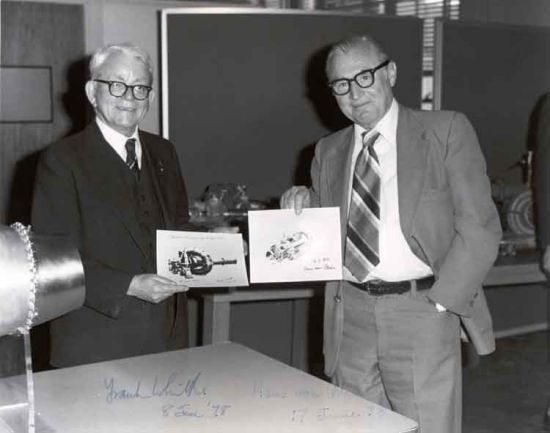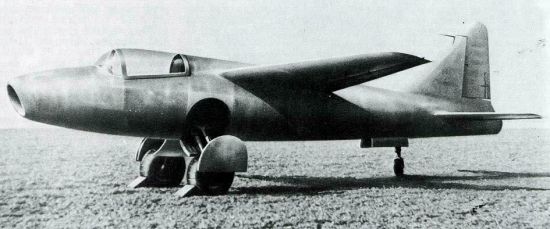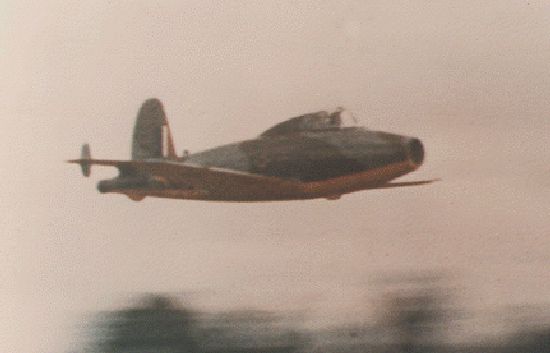|
||||||||||
|
|
||||||||||
|
||||||||||
|
|
||||||||||
I have some doubts about the first jet aircraft to fly, I believe I have read that an Italian jet aircraft
flew in 1938-39. Could you find any information to confirm this?
- question from Donald Shaw

Meanwhile, German engineer Hans von Ohain had begun his own independent studies of jet propulsion in the early 1930s while working on his doctorate at Göttingen University. von Ohain had completed a working model of his engine by 1935 and approached Ernst Heinkel about building an aircraft to test such a device. Detailed work to design and build both a more powerful engine and a suitable airframe began in 1937, and von Ohain's engine was the first jet to fly when the Heinkel He 178 took to the air on 27 August 1939.

Back in Britain, the Air Ministry had become sufficiently impressed with Whittle's ground tests that an order was placed for a flight-worthy engine to be installed in an aircraft built by Gloster. The aircraft was completed in March 1941 and the engine the following May. Whittle's engine was first flown in the Gloster E.28/39 on 15 May 1941.

Although it took several more years for both nations to recognize the value of the jet engine, both the Royal Air Force and German Luftwaffe put out requests for jet-powered fighters. The resulting Messerschmitt Me 262 and Gloster Meteor both saw action in the closing months of World War II.


Whittle's engine design was also provided to the United States where General Electric made some improvements and used the new engine in the Bell P-59 Airacomet. Other early jets developed during WWII included the Heinkel He 162 and He 280 as well as the Lockheed P-80 Shooting Star. Germany also supplied plans and even a complete jet engine to Japan late in the war allowing the Japanese to build their own version of the Me 262 known as the Kikka.
Italy's entry into the "jet" arena was the Campini-Caproni CC-2. But unlike the German and British aircraft, the CC-2 was not powered by a true jet engine. To be more precise, the type of engine most people refer to as a jet is known by the more official title of a gas turbine. The most important component of the gas turbine is a stage towards the aft end of the engine called a turbine. Hot exhaust gases created by burning a mixture of fuel and incoming air passes through the turbine causing it to spin. This spinning motion provides power that is used to turn a shaft connected to a compressor stage at the forward end of the engine. The compressor pulls additional air into the engine and compresses it to a high pressure so that it can be combusted with fuel to continually produce thrust. This process is illustrated in the following diagram of the Junkers Jumo 004B turbojet engine used aboard the Me 262.

The engine used aboard the CC-2, on the other hand, operated in a fundamentally different manner. The concept was developed by Secondo Campini, an Italian engineer who began studying propulsion systems in the early 1930s. The idea he came up with was known as the thermojet, and it can be thought of as a hybrid between a classic piston-powered propeller engine and the turbojet. At the heart of the thermojet is a traditional internal combustion piston engine, like those that had been used since the days of the Wright brothers. A piston engine operates just like an engine in a typical automobile. A mixture of air and fuel is combusted inside a cylinder, and the force generated by that combustion is used to move a piston and generate mechanical work. In the case of an aircraft, that mechanical work turns a propeller in order to generate thrust.

What Campini did in his thermojet was place a piston engine within an enclosed duct, as illustrated above. The mechanical energy of this engine was used to turn three propellers placed behind the engine. Two of these ducted propellers were used to compress the incoming air while the third helped to direct the flow and minimize turbulence within the engine. This compressed air was mixed with fuel by means of a ring of kerosene injectors in the aft portion of the duct. The mixture was then combusted and exhausted out of the nozzle at high speed to produce thrust. Conceptually, the engine can almost be thought of as adding an afterburner to a piston-powered propeller engine.

Though Campini's engine was an interesting innovation, it was not as efficient or effective as the turbojet. The thermojet was most efficient at sea level where the air density and pressure is highest, but generates increasingly less power as altitude increases. In addition, the thermojet was far larger and heavier than a turbojet, and the piston engine needed to power the compressors was quite complicated. Combined with the low efficiency of the burner stage, the maximum power output of the engine was quite low. For these reasons, the turbojet and the related turbofan have become the dominant forms of aviation propulsion while the thermojet faded into obscurity. One of the few applications where the thermojet found a home was in later versions of the Japanese Ohka kamikaze aircraft, but this engine was deemed too underpowered and replaced by a turbojet.
As for what jet-powered plane flew first, the CC-2 was beaten out by Germany's He 178 by exactly one year. The He
178 first flew on 27 August 1939 and the Campini-Caproni CC-2 on 27 August 1940. Following closely behind was the
British Gloster E.28/39 that took to the air for the first time on 15 May 1941.
- answer by Jeff Scott, 5 October 2003
Read More Articles:


|
Aircraft | Design | Ask Us | Shop | Search |

|
|
| About Us | Contact Us | Copyright © 1997- | |||
|
|
|||